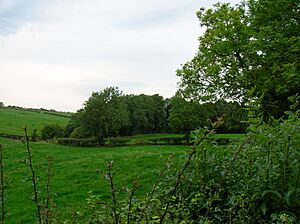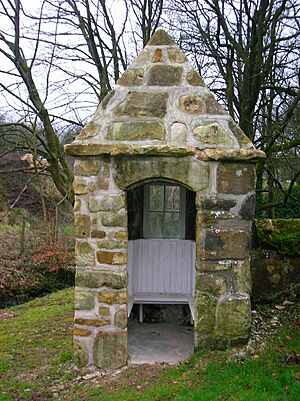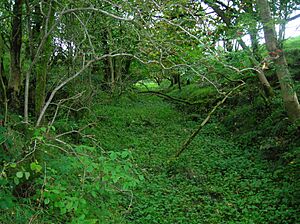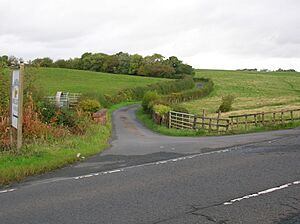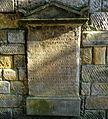Monkredding House, North Ayrshire facts for kids
Quick facts for kids Monkredding |
|
|---|---|
| Kilwinning, North Ayrshire, Scotland UK |
|

Monkredding House
|
|
| Coordinates | 55°40′25″N 4°40′01″W / 55.673489°N 4.666906°W |
| Grid reference | NS3240 4534 |
| Site information | |
| Owner | Private |
| Controlled by | Nevin Clan |
| Open to the public |
No |
| Condition | Excellent |
| Site history | |
| Built | 16th century |
| Built by | Thomas Nevin |
| In use | Inhabited |
| Materials | Freestone |
Monkredding is a historic house and estate located in North Ayrshire, Scotland. It sits between the towns of Kilwinning and Auchentiber. The name "Monkredding" means 'Monk's Garden'. It was once a special resting place for the Tironensian monks from Kilwinning Abbey.
Monkredding House is still in great shape today and is used as a private home. It has a long and interesting history, with different families owning it over the centuries.
Contents
History of Monkredding
The Nevin family first bought the lands of East and West Monkredding from the Abbot of Kilwinning Abbey between 1539 and 1545. Thomas Nevin was the first private owner of these lands. At this time, the abbots were starting to sell off parts of the abbey's land. They knew their own control over the lands was becoming uncertain.
Thomas Nevin became very rich from mining and selling coal found on his land. This wealth allowed his family to build a strong tower house at Monkredding.
Monkredding House Through Time
Thomas Nevin, the first owner, started building Monkredding House. It was originally an 'L' shaped building, designed to be strong like a small castle. Over the years, it has been changed a lot. A large new part was added in 1905.
The oldest parts of the house, like the west wing, have a date stone that says '1602' or '1605'. Other parts were added in 1638. The house has thick stone walls, covered in a white plaster called harling. The roof has been changed, and a round stair-tower was made taller.
In the early 1800s, the house was made even bigger and its main entrance was moved. Monkredding House is officially recognized as a historic building. Some old maps from the late 1800s even show it as a ruin, meaning it was unroofed and falling apart at one point.
The Grounds of Monkredding
Old maps from the 1700s and 1800s show that Monkredding had lots of woodlands around it. A very old beech tree, about 400 years old, fell here in the 1920s. Some large beech trees still stand near the road, showing where the old woodlands used to be.
There is also a historic summerhouse on the property. The house once had a different main entrance with a lodge called 'Golconda'. This entrance was later abandoned, probably because of nearby limestone mining. A new entrance and lodge were built instead. The name 'Golconda' comes from a ruined city in India, but why it was used here is a mystery.
The Monkredding Estate
The Monkredding estate was quite large, covering about 700 acres, and later grew to over 1000 acres. It included many farms like Monkredding, Hullerhill, and Gooseloan.
The Families of Monkredding
Many families have owned Monkredding over the centuries. Each family left its mark on the estate.
The Nevins
The Nevin family owned Monkredding House from 1532 until the late 1600s. The family name has been spelled in many ways, like Nevin, Nivens, and Newin. It's thought to come from old Irish words meaning "bone" or "little saint."
Thomas Nevin and his wife Elizabeth Crawford were the first Nevins to own Monkredding. They were related to other Nevin families in the area.
Around 1562, Andrew Nivin supported the Reformation, a big religious change in Scotland. He was a "Bonnet Laird," meaning he was a tenant farmer who became a landowner.
The Nevin family had several generations of owners. For example, Andrew Nevin inherited the estate in 1581. Later, William Nevin, the last Nevin owner, sold Monkredding in 1698 to Hugh Cuninghame. The Nevin family also owned land in Northern Ireland.
The Tam o'Shanter Connection
Towards the end of the 1600s, some Nevin brothers from the Monkredding area moved to Girvan. One of them, John Niven, was a blacksmith. He was known for building a special cart with wheels that turned on a fixed axle. At that time, most farmers still used sleds.
It's believed that John Niven is the blacksmith mentioned in Robert Burns' famous poem 'Tam o'Shanter'. His son Robert might have been the miller in the poem.
The Cuninghames
In 1698, the Cuninghame family bought Monkredding. Hugh Cuninghame of Clonbeith was the first Cuninghame owner. His son, George Cuninghame, then inherited the estate.
George Cuninghame married Agnes Dallas in 1714. They had a son, also named George, who later married Janet Gemmel. Their eldest daughter, Agnes, married William Miller of Monkcastle. When Ferguson Cuninghame, who was unmarried, died in 1830, the estate was split among his sisters' heirs. Agnes Miller inherited the main house.
The Millers
The Miller family became owners of Monkredding through Agnes Cuninghame, who married William Miller of Monkcastle. When Agnes's brother died, she inherited one-third of the Monkredding estate.
Her son, William Alexander Miller, inherited the estate in 1802. He had nine children. His eldest son, William Miller, took over in 1828. William was a lawyer and a leader in the Freemasons. He had three sons and two daughters. His two older sons died young, so when William Miller died in 1846, the estate went to his youngest son, William Campbell Miller.
William Campbell Miller died at just fifteen years old in 1857. His sisters then inherited the estate.
The MacAlisters
Keith MacAlister inherited Monkredding through his wife, Alexandrina Georgiana Cuninghame MacAlister. She passed away in 1924.
Their son, Captain MacAlister, a retired naval officer, then owned the estate. He had been very ill with Yellow Fever. The estate at this time included four farms and some woodlands.
Tenants of Monkredding
Over the years, various people lived at Monkredding House as tenants. John Smith, a well-known archaeologist and historian, lived at the 'Golconda' lodge on the estate in the late 1800s. He wrote some of his books there. At that time, the main house was a ruin.
In 1956, Colonel B M Knox was living in the house. Old records also show other families, like the Dickies and George Speirs, living at Monkredding House in the 1800s.
The Second Earl of Eglinton
Thomas Nevin of Monkredding was a good friend of Hugh, the second Earl of Eglinton. In 1546, the Earl became very ill while visiting Monkredding and sadly died there. This was even though his own home, Eglinton Castle, was only a short distance away. In his will, the Earl chose Thomas Nevin to be one of the guardians for his son, the third Earl.
Mining Around Monkredding
Coal and limestone mining was very important in the Monkredding area. Records from 1608 show large coal workings. These mines were very valuable because the coal could be dug out without needing to pump out water. This was a big advantage in those days.
The mining operations came so close to Monkredding House that the main entrance had to be moved. Monkredding Quarry was a large quarry for freestone, a type of stone used for building. It also had limestone and coal pits. In 1874, Monkredding was listed as one of the active mines in the Irvine area.
Many of these mines eventually closed. For example, the Goldcraig limestone quarry closed in 1891, and the Wee coal working closed in 1927.
Lylestone Row
The ruins of Lylestone Row can be seen near Monkredding House. In the 1800s, this row of six homes was where workers from the nearby quarries and coal pits lived. There was even a blacksmith's shop and a small railway that brought minerals from the quarries.
The quarries eventually closed, and the community of Lylestone Row slowly declined and was abandoned in the late 1900s. Today, Monkredding Quarry is a protected area for nature.
More Interesting Facts
- Some people believe there was a secret underground tunnel connecting Monkredding House to Kilwinning Abbey.
- Goldcraig farm has been taken down, and the site is now used by the local council. An old map from 1897 shows a toll gate at Goldcraig.
- The monks of Kilwinning Abbey had the right to get stone from Goldcraig Quarry. It's thought that much of the abbey was built using stone from here.
Images for kids


